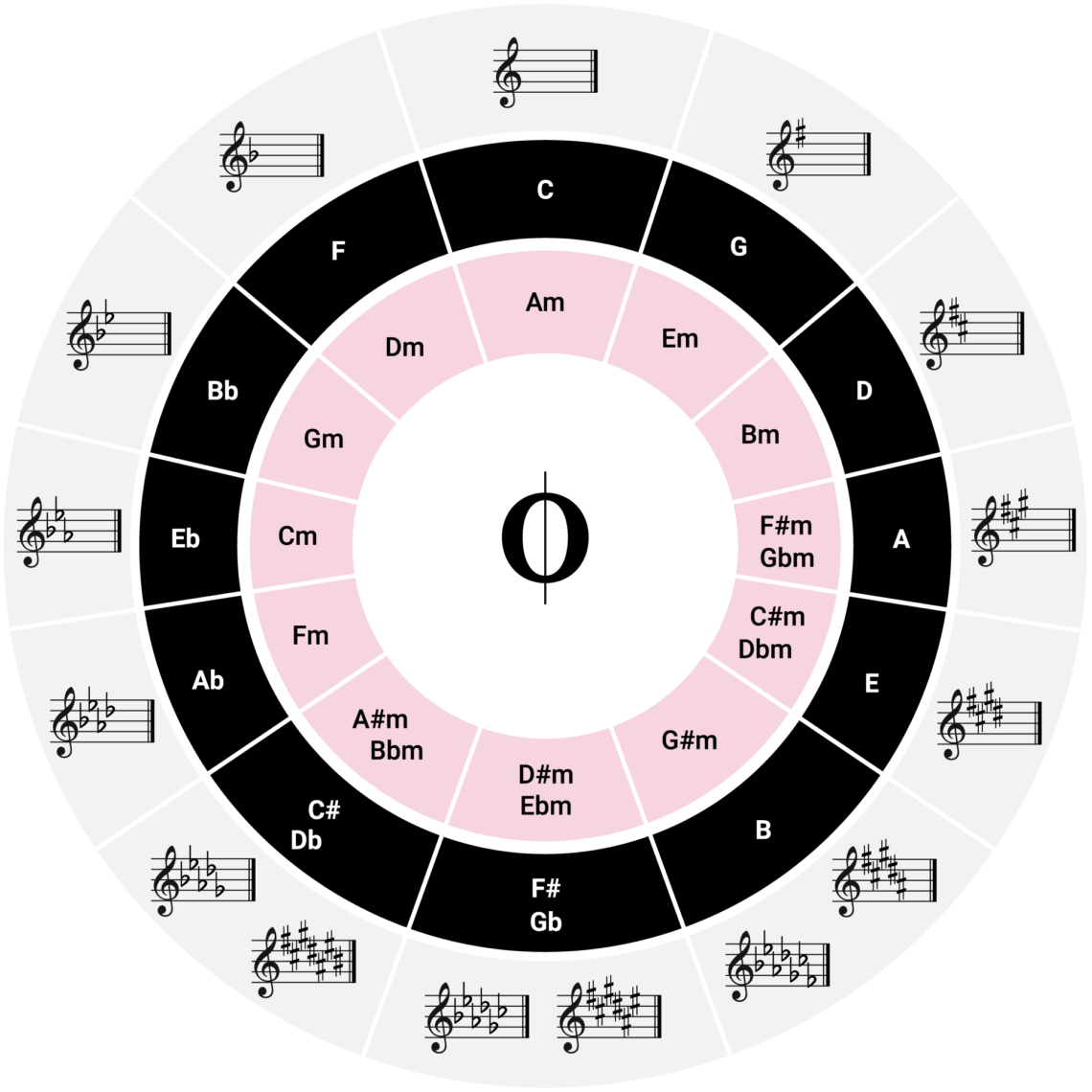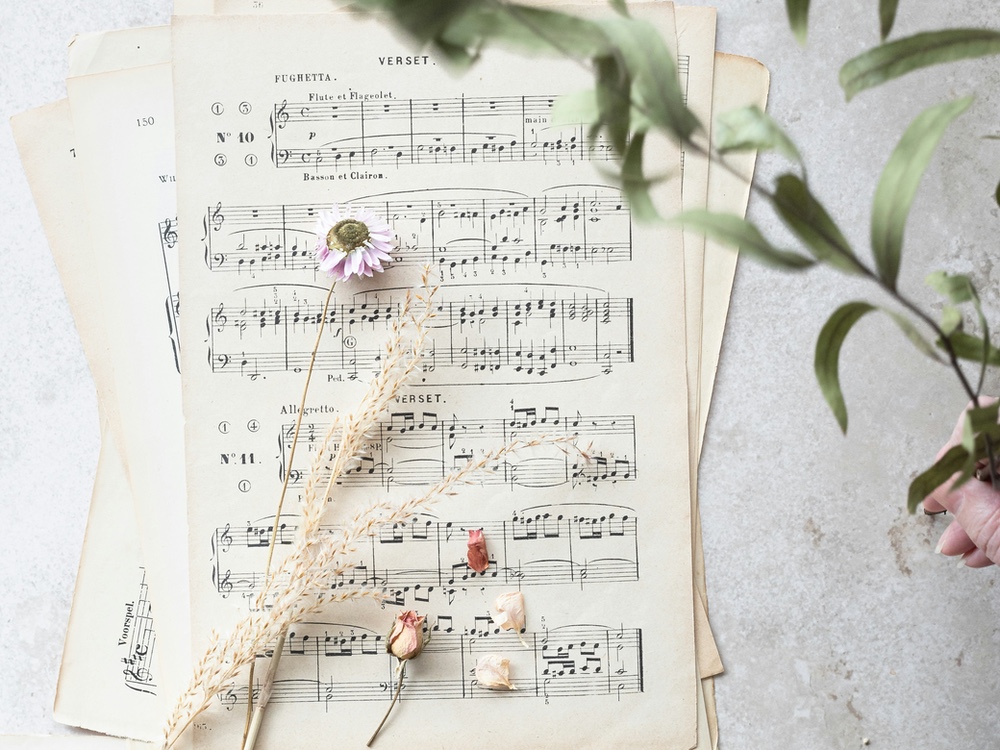Knowing the chord formulas, scales, and chord progressions are very helpful, but one of your best references is the Circle of Fifths. Whether you are playing an acoustic or digital piano your practice space should include a few printed out reference sheets – and the Circle of Fifths is one of them. Don’t keep them in a device, actually print the photo or chart and somehow hang it in sight as you play. You want to easily be able to break the sheet music down that you are playing.

Download the Circle of Fifths as printable PDF for free
What is the Circle of Fifths?
The Circle of Fifths shows us how all 12 notes in the chromatic scale relate to one another. While they may not be in alphabetical order they are in a specific musical order. If you move clockwise each note is a fifth from one another, counterclockwise each note is a fourth. Starting with C we move 5 steps up and get G, 5 steps more D, and so on until we make our way back to C again!
There are 3 circles that each give us some different info; the inner ring the relative minor, the next ring the relative major, and the outer ring the key signature. And each ring runs on very simple rules that allow us to understand notes, chords, and keys. Make sure to follow along with the Circle of Fifths as you read.
How to Use the Circle of Fifths
So how do we know what sharps or flats a key has? Well if you are looking at the Circle of Fifths the right side is sharp and the left is flat, each movement downward adds another sharp or flat. At the top C has none and if we move to G it has one sharp, or to F it has one flat, and so on.
You can tell which notes are sharp by moving 7 notes up, for example if we take G and go up 7 notes we have an F(#). If we move to the key of D and add 7 notes we get C#, but we also add the last F# on also. We keep adding these sharps on until we reach C#, going any further is just too many accidentals. Instead of writing a key as A# with 10 sharps, it is easier to use two flats in the enharmonic Bb.
On the left we only move 4 notes up to find the flat note. The fourth note in the key of F is Bb, and the fourth note for Bb is Eb. Just like the sharp side we keep adding the last flat onto the next until we reach Gb with 6 flats. The F#/Gb and C#/Db can both be written either way depending on what music you are working on. You can double check your sharps and flats by using diatonic scale formulas like the major; tone-tone-semitone-tone-tone-tone-semitone.
The next circle in is all the major keys one equal tempered fifth apart. And again you will know whether a key is flat or sharp depending on where it is. The third and final circle is the relative minor key which you can find by moving 6 notes up or 3 back from the major. So if we move 3 back or 6 up from C we get Am. And this is where music theory gets confusing is the multiple ways to find an answer!
Ways to Use the Circle of Fifths
Of course the easiest thing to find with the Circle of Fifths is the key signature for each key (which both relative major and minor share). It can also help you find your basic diatonic major and natural minor scales and their notes. It also contains a clever little way to know what your major and minor chords are with these shapes;

By moving these triangles above we can figure out most of our basic triads. If we move that shape to the key of E then the E chord is made up E-G#-B. Of course we can check this in other ways. It also tells us our chords in each key. By moving right or left we get our IV and V chords, and the ii and iii is simply the minor of IV and V!
| Key | I | ii | iii | IV | V | vi |
| C major | C | Dm | Em | F | G | Am |
| G major | G | Am | Bm | C | D | Em |
| D major | D | Em | F♯m | G | A | Bm |
| A major | A | Bm | C♯m | D | E | F♯m |
| E major | E | F♯m | G♯m | A | B | C♯m |
| B major | B | C♯m | D♯m | E | F♯ | G♯m |
| F♯ major | F♯ | G♯m | A♯m | B | C♯ | D♯m |
| C♯ major | C♯ | D♯m | E♯m | F♯ | G♯ | A♯m |
| C♭ major | C♭ | D♭m | E♭m | F♭ | G♭ | A♭m |
| G♭ major | G♭ | A♭m | B♭m | C♭ | D♭ | E♭m |
| D♭ major | D♭ | E♭m | Fm | G♭ | A♭ | B♭m |
| A♭ major | A♭ | B♭m | Cm | D♭ | E♭ | Fm |
| E♭ major | E♭ | Fm | Gm | A♭ | B♭ | Cm |
| B♭ major | B♭ | Cm | Dm | E♭ | F | Gm |
| F major | F | Gm | Am | B♭ | C | Dm |
Another great use for the Circle is finding potential keys to modulate and substitute. In jazz it is common to work your way from chord to chord using secondary dominants, which is the fifth of the fifth! The fifth of C is G and the fifth of G is D, so if you wish to move from the key of C to G, that D will make a great pivot chord! Jazz also focuses on the Circle of Fourths, which as mentioned is moving counterclockwise.
Famous Music Using the Circle
By far the most famous music written with the Circle of Fifths is Bach’s Well-Tempered Clavier, which has 24 preludes and fugues. It covers all 12 major and 12 minor keys and was specifically written for the purposes of presenting all the keys to the student and audience. What better way to teach all 12 keys then simply writing a lot of music that covers them all!
As far as other examples, plenty of the music you will play is tonal and focuses on a tonic center. In cases of folk and simple pop it will mostly stay in one key or one segment of the Circle. But as we get into more complicated classical and jazz music we will notice more movement as we modulate keys.
The Circle of Fifths is really double sided, as it is super useful in some ways and dull in others. As a new student it is an essential part of learning to play piano or any instrument, it is all the basic rules of western music in one simple graph. However as we progress and memorize it over time we will need it less. Which is great news, because once you completely understand the Circle of Fifths you will be on your way to being a great piano player!



